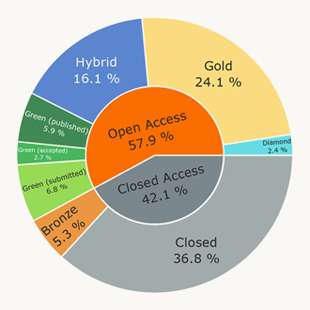BIBLIOMETRICS
Intro to Bibliometrics
Bibliometrics is an interdisciplinary research and application field concerned with the measurability and quantitative analysis of scientific publication and citation data. The basis for this is data describing scientific articles, such as author names, titles, journal or series titles, year of publication, affiliations (=organisational addresses) of the authors, one or more subject classes for the disciplinary classification of the publication, and information on the research funding from which the publication originated. In addition, there are citation counts (and partly further contextual data on citations), which can be used to examine the reception of publications. This data is generated as meta and, so to speak, process data in the publication system and is primarily processed for information retrieval purposes in databases such as Web of Science, Scopus and, more recently, OpenAlex.
A central premise of bibliometrics is that information on scientific publications—as key outputs of research—and their citations can, beyond their individual content, yield insights into the structures and dynamics of the publication and science system when analyzed in aggregated form. One of the historical roots of bibliometrics lies in the search for empirical laws, such as Bradford’s Law, originally developed in a library science context. In a related field, patents are often used to analyze knowledge transfer processes towards commercial application.
A core area of classical, evaluative bibliometrics is the development, assessment, and use of indicators to measure characteristics of publication corpora. These indicators are used for the evaluation of institutions, sectors, countries, or individual researchers and research groups. Due to differences in disciplinary cultures, indicators should be field-normalised or otherwise not used for interdisciplinary comparisons. Field-normalised citation rates (FNCR), the field-normalised proportion of highly cited publications or collaboration indicators are used, for example. In contrast, the Journal Impact Factor (JIF) or the H‑index are often critically discussed in the field.
Due to the specific nature of the data, which, as explained above, was not primarily created for this purpose, techniques for data cleansing, disambiguation of entities (especially authors, organisations and research funders) and matching different data sources, as well as methods such as clustering based on co-citations or bibliographic coupling for science mapping, for example.
These techniques, methods, and indicators are also applied in exploratory research settings and contribute to quantitative science and innovation studies—for example, in analyzing the impact of funding programs, gender disparities, the identification of innovations and emerging research fields, or studies on scientific misconduct.
While such questions are typically addressed using statistical analysis, bibliometrics has increasingly developed methodological interfaces with other fields, such as network analysis and information retrieval. It can also be combined with qualitative approaches. Moreover, growing access to full texts and advances in natural language processing (NLP) and large language models (LLMs) are additionally enabling the increased consideration of the semantic level in the analysis of publication corpora.
Further information can be found in the Bibliometrics Quick Notes by Dr. Stephan Gauch, which were developed in the context of the KB and funded by the Federal Ministry of Research, Technology and Space.
The Open Access Monitor Germany
The Open Access Monitor Germany is a tool that monitors the publication output of German scientific institutions in scientific journals. Data from existing source systems, such as the database of the KB, are first collected and aggregated. These data are then made accessible and usable in a freely available application and, in a further step, used to inform research published in scientific publications. In this way, these findings are made available again to the scientific community and the interested public, offering libraries, funders and researchers a freely available tool to analyse publications, the citations they contain, and the associated publishing costs.
Furthermore, the Open Access Monitor monitors and enables support for the change in the publication system towards Open Access via continuous analysis of funds spent on journal subscriptions and publishing fees. The frequent delivery – up to weekly – of data from existing data sources means that users are always provided with up-to-date data. The ability to filter search queries in the user interface supports different usage scenarios. The Federal Ministry of Education and Research (BMBF) funds the ongoing development and operation of the Open Access Monitor Germany through the central library of the Research Centre Jülich in the project “OAM — Open Access Monitoring” (FKZ 16OAMO001).
The open access monitor records the publication output of German academic institutions in scientific journals. The transition to an open access system can be observed on the basis of analyses of subscription fees and publication fees.

Distribution of journal business models
The graph shows the current distribution of journals (33,150) across journal business models; based on the Crossref title list, and the journal lists used in the OAM (DOAJ, DOAG, transformative agreements).

Distribution of journal articles in Germany
The graph shows the open/closed access ratio of journal articles (764,825) in Germany for the last five years (2018–2022) based on Dimensions, Unpaywall, and the journal lists (DOAJ, DOAG) used in the OAM.
Digital Bibliometric Window
Documentation and analysis of bibliometric indicators
The Pact for Research and Innovation (PFI) is an agreement between the German federal and state governments and five science and research organisations. In the PFI, the science and research organizations receive financial planning security through agreed annual increases in institutional grants. In return, the pact partners have committed themselves to common research policy goals. For the current fourth phase, the pact partners have agreed on five central research policy goals. These are: 1. Promote dynamic development, 2. Strengthen transfer in business and society, 3. Deepen networking, 4. Attract and keep the best minds, and 5. Strengthen infrastructures for research.
The objective of the project is to write a report for the four non-university research organizations based on analyses of bibliometric indicators in each of the years 2022 to 2026, while also recording the entire German science system and its development as well as trends and dynamics and classifying them both nationally and internationally. Only bibliometric indicators are used in this monitoring report. This report is intended to provide bibliometric indicators for all non-university research organizations in Germany using standardized methods, which provide the organizations themselves, the GWK and an interested public with empirical facts for their own assessment.
